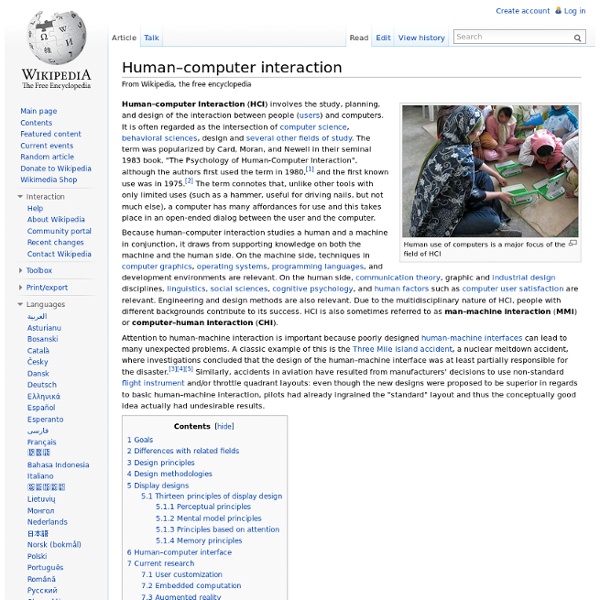Senseg creates textures on perfectly flat touchscreen displays
Senseg might have been around since 2008, but the company has now built a prototype of its displays into a tablet. The tactile panel tech uses electrostatic fields to simulate different levels of friction, allowing it to generate the sensation of texture on a totally flat screen. CNET got a chance to try out the display, and said that the textures it creates are easily recognisable — moving from gravel, to packing material, to sandpaper creates distinct, familiar feelings. The video also shows the potential implications for gaming, opening up a new level of immersion for designers. Unlike other haptic technologies, there's no reliance on moving parts or any physical change to the screen, meaning that Senseg's concepts could be integrated into the same devices we use today.
Interakcija čovjek-računalo
Sadržaj 0. Uvod 1. Tehnike interakcije 1.1. 1.1. 1. 1.1. 2. 1.1. 3. 1.1. 4. 1.1. 5. 1.1. 6. 1.1. 7. 1.1. 8. 1.1. 9. 1.1.10. 1.1.11. 1.2. 2. 2.1. 3. 3.1. 3.2. 3.2.1. 3.3. 3.3.1. 3.4. Ovaj se tekst najvećim dijelom temelji na materijalima prikupljenim na stranicama svjetskih sveučilišta koja se bave problematikom HCI-a, poput Berkleya i Stanforda. 0. S iznimkom nekih ugradbenih softvera i operacijskih sustava, uspjeh softverskog proizvoda određen je ljudima koji koriste taj proizvod. 1. 1.1. Tehnički aspekti interakcije čovjek - računalo oduvijek su bitno ovisili o raspoloživim uređajima za komunikaciju sa računalom. 1.1.1.Algebarski jezici Kada su se programi počeli osmišljavati i pisati za radnim stolom i potom učitavati u računalo putem papirnatih traka, interakcija sa strojem postala je sličnija matematičkoj aktivnosti. 1.1.2. Komercijalni proizvodi namijenjeni obradi podataka koristili su već kreirano sučelje za spremanje i procesiranje bušenih kartica. 1.1.3. 1.1.4. 1.1.6. 1.1.7. 1.2.
Toshiba brings texture to touch (video)
Reach out and touch whatever screen you're reading this on. What if, instead of feeling the glass or plastic beneath your finger, you could experience the texture of a brush, woodgrain, or even a stone? Well, Toshiba's working on just such a project, which operates on the basis of a film affixed to, say, a smartphone's touch panel -- electrical currents are sent through this layer, and your digits are shot up with the simulated sensation of touching those various surfaces. Comments
Virtualna stvarnost
Što je virtualna stvarnost? Virtualna stvarnost (engl. virtual reality - VR) je kompjuterski simulirana realnost, računalno stvoreno vizualno, auditivno i taktilno iskustvo koje korisniku pruža realističan osjećaj „uranjanja“ u drugi svijet. Virualna stvarnost ostvaruje se korištenjem različitih uređaja za interakciju između čovjeka i računala u kombinaciji sa vrlo brzim i naprednim računalima i brzom komunikacijskom mrežom. Kratka povijest virtualne stvarnosti: Koncept virtualne stvarnosti seže još iz pedesetih godina prošlog stoljeća kada je kinematograf Morton Heilig izgradio konzolu „Sensorama“ koja je unatoč revolucionarnoj ideji, na tržištu loše prošla. Slika - „Sensorama“ Ivan Sutherland, kojeg smatramo pionirom računalne grafike i prividne stvarnosti, razvio je 1965. Slika - „The Ultimate Display“ Tablica - Prikaz daljnjeg razvoja VR
to Acquire Perceptive Pixel Inc.
REDMOND, Wash., and NEW YORK — July 9, 2012 — Microsoft Corp. and Perceptive Pixel Inc. (PPI) today announced that they have entered into a definitive agreement under which Microsoft will acquire PPI, a recognized leader in research, development and production of large-scale, multi-touch display solutions. “The acquisition of PPI allows us to draw on our complementary strengths, and we’re excited to accelerate this market evolution,” said Kurt DelBene, president, Office Division for Microsoft. “PPI’s large touch displays, when combined with hardware from our OEMs, will become powerful Windows 8-based PCs and open new possibilities for productivity and collaboration.” Founded in 2006 by Jeff Han, a renowned pioneer in multi-touch technology, PPI shipped its first multi-touch workstation and large wall solutions in early 2007. In 2008 its technology gained widespread recognition for transforming the way CNN and other broadcasters covered the 2008 U.S. presidential election. About Microsoft
Virtualnost
Virtualnost označava svojstvo nečega, da bi u stvarnosti trebalo biti tamo ali nije realno. Dakle ne postoji u obliku u kojem prividno postoji, ali po svojim biču ili učinku djeluje kao nešto što i u stvarnosti postoji. Riječ potječe iz francuske riječi virtuel (u mogućnosti djelovati, moguće) koja pak potječe iz latinskog virtus (vrlina, hrabrost, sposobnost, snaga, muškost). Pierre Levy više filozofski definira virtualnost kao što postoji potencijalno, a ne zapravo. Općenito možemo razlikovati dvije vrste virtualnih prostora: u ograničenom ili zatvorenim prostoru (CD-ROM-ove, igre, simulacije ...) kao i one koje sudostupne preko interneta i otvorene za interakciju, transformacije, te poveznice na druge svjetove i okruženja. Stoga, virtuala realnost navodi primjerice na nešto što u fizičkim smislu nije prisutno, ali prisutno svojom funkcionalnošću ili djelovanjem. Često se u fikcijama stvaraju virtualni likovi, kao na primjer, u računalnim igrama , stripovima ili crtani filmovima.
Virtualni svijet
Oprema za virtualnu realnost Padobranac US-Navya vježba virtualno skokove Virtualni svijet ili virtualna stvarnost (engl. Virtual Reality) je oblik računalne simulacije, u kojoj se sudionik osjeća da se nalazi u umjetnom okruženju. Sudionik može gledati kroz dva malena monitora (po jedan za svako oko). Senzori detektiraju kretanje glave ili položaj tijela, što uzrokuje promjenu virtualnog promatranja položaja. telekirurški zahvati,vojne vježbe,arhitektura iliu svrhu zabave. Korisnici virtualne stvarnosti vide virtualni svijet i dijelove svojeg tijela (ruke, tijelo ...) kao dio virtualnog svijeta pomoću elektroničke opreme (rukavice, kaciga, odjeća, i drugog). OpenSource Projekti On The Net - Resources in Virtual Reality, engleski




by raviii Nov 28